|
|
|
Sort Order |
|
|
|
Items / Page
|
|
|
|
|
|
|
| Srl | Item |
| 1 |
ID:
150661
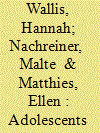

|
|
|
|
|
| Summary/Abstract |
With respect to changes in the energy systems of many countries, electricity consumption in households is an important topic. Extensive research has investigated the various determinants of electricity consumption. However, insights into how specific sociodemographic, behavioural, and attitudinal determinants influence residential electricity consumption are still scarce. In this study, we used hierarchical regression analysis to systematically investigate these determinants (including household engagement in electricity saving) along with a wide range of other measures in a sample of German households (N=763). Special attention was given to households with adolescents and children by analysing the influence of the number of adolescents on electricity consumption in a path model. Our results indicate that sociodemographic influences can be explained by the purchasing and use behaviours of residents. Our findings also suggest that the use of behavioural information provides a more detailed picture of the conditions of electricity consumption and thus allows for more appropriate policy planning.
|
|
|
|
|
|
|
|
|
|
|
|
|
|
|
|
| 2 |
ID:
157798
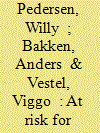

|
|
|
|
|
| Summary/Abstract |
Little is known about attitudes among ordinary adolescents in favour of the use of political violence and radicalization. We draw on a survey from a population sample of adolescents (n = 8627) in the Norwegian capital, Oslo. We first compared adolescents with Muslim, Christian and no religious affiliation with regard to attitudes in favour of the use of violence for political purposes and support of those who go to Syria to take part in active combat. Muslim youth reported higher levels of support for the use of violence to obtain societal change than did other adolescents. The same pattern was revealed with regard to support for the fighters in Syria. After control for other variables, Muslim affiliation had no impact on attitudes in favour of politically motivated violence, though it remained significant for support for the fighters in Syria. However, here as well we found associations with poor school grades, conduct problems and exposure to violence, possibly indicating an emerging adolescent ‘outsider’ position. Political activity on social media also played a role. Such attitudes rarely develop into politically motivated violence and jihadism. However, for a small minority, they may represent the first step in that direction.
|
|
|
|
|
|
|
|
|
|
|
|
|
|
|
|
| 3 |
ID:
188106
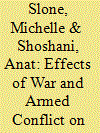

|
|
|
|
|
| Summary/Abstract |
Although research on the consequences of war exposure on children’s mental health has made significant progress in the past decades, a lack of valid measures for quantifying the incidence, severity and variability of exposure can hamper identification of at-risk children and mental health delivery in conflict-affected areas. The present study investigated the psychometric properties of a new political life events scale for youth (PLE-Y) that comprehensively assesses personal political violence exposure history. The PLE-Y was administered to 6,254 adolescents aged twelve to eighteen in two large samples in a region in Israel that has been characterized by high exposure to political violence. Adolescents were assessed for political life events exposure, psychiatric symptoms, emotional and behavioral problems, and subjective well-being. Exploratory and confirmatory factor analyses supported a two-factor structure of the PLE-Y (severe and mild), representing the severity levels of exposure. Results confirmed positive relations between severity of PLE exposure and psychiatric symptoms, emotional and behavioral difficulties, and lower subjective well-being. This study demonstrated the importance of taking into account the personal political violence exposure history and the subjective interpretations of impact of the events to accurately identify the mental health risks to youth who are chronically exposed to protracted political violence.
|
|
|
|
|
|
|
|
|
|
|
|
|
|
|
|
| 4 |
ID:
161585
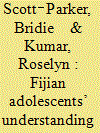

|
|
|
|
|
| Summary/Abstract |
Pacific Island countries are particularly vulnerable to future manifestations of climate change due to high coastline‐to‐land‐area ratios, and high dependence of inhabitants on natural ecosystems. While everyone in the Pacific Islands should participate in climate change adaptation activities, it is the young people, given they are the generation likely to not only bear the burden of climate change, but to lead and live effective climate change adaptation activities and strategies specific to their region, the involvement of youth is critical. Pacific Island youths are often marginalised within traditional decision‐making hierarchies, therefore they are typically excluded from participating in meaningful discussions at community and government levels. Discussions were held with 30 adolescents aged 14–18 years in Fiji to explore knowledge and experiences regarding climate change. Participants revealed their dismay at their inability to talk to family – who they consider are not doing enough – about what they consider as appropriate responses to climate change, recommending the help of an authoritative outsider who could speak to their community leaders and family. Discussions also revealed that Fijian youth could not distinguish between changes in the climate and normal weather events, attesting to the importance of climate‐change education and awareness‐raising efforts within the Pacific Islands more generally.
|
|
|
|
|
|
|
|
|
|
|
|
|
|
|
|
| 5 |
ID:
147002


|
|
|
|
|
| Summary/Abstract |
This study investigated the relationship between self-reported discrimination and ethnic identity among 61 Arab American adolescents between the ages of 12 and 18 years. Participants completed the Multigroup Ethnic Identity Measure (MEIM) to obtain an assessment of their ethnic identities. Additionally, the lead author developed a questionnaire asking participants to self-report if either they or another Arab student they knew had been ‘treated badly or differently because of their ethnicity’. Consistent with the rejection-identification model, respondents who had reported experiencing discrimination, knowing of others who had experienced discrimination, or both had higher ethnic identity scores than those who had not, although the only significant difference was found between the group that experienced both types of discrimination and the non-discrimination group. Implications of these results are discussed as well as directions for future research.
|
|
|
|
|
|
|
|
|
|
|
|
|
|
|
|
| 6 |
ID:
171070


|
|
|
|
|
| Summary/Abstract |
This article explores the integration of ethnic minorities into the middle class in a novel way. Current literature examines the existence of boundaries and the ways they construct ethnic identifications through visible acts. One line of research perceives the middle class as a homogenizing platform that lowers residential segregation and labor market discrimination, while another demonstrates how stereotypes and an occupational glass ceiling continue to operate, reinforcing minorities’ ethnic identifications. By contrast, this article demonstrates the significance of invisible boundaries for the study of ethnicity in the middle class. I center on the ways whereby microaggression, namely tacit everyday insults, signifies an ethnic difference between middle-class adolescents. Analyzing adolescents’ narratives shows how the classification of spaces has given rise in minority adolescents to inner experiences of incongruence and subordination. By constructing an ethnic identity that prevents adolescents perceiving themselves as middle-class subjects, invisible boundaries reinforce the ethno-class order.
|
|
|
|
|
|
|
|
|
|
|
|
|
|
|
|
| 7 |
ID:
096396
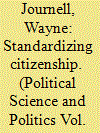

|
|
|
|
|
| Publication |
2010.
|
| Summary/Abstract |
The rise of state-mandated standards in public education have allowed legislators to answer the question of what constitutes a proper civic education, a debate that has existed in the United States since the turn of the twentieth century. Through the content they employ in their standards, states may indirectly influence the type of citizenship education students receive in the classroom. The present study focuses on the Virginia Standards of Learning for two courses, civics and economics and U.S. and Virginia government, which are commonly taught to eighth graders and high school seniors, respectively. A content analysis of the essential knowledge found in the standards for these courses categorizes instructional content into seven forms of citizenship: civic republicanism, character education, deliberative, social justice, participatory, transnational, and cosmopolitan. Although the results are specific to the Virginia Standards of Learning, the nature of how citizenship is portrayed within the standards may transfer to other states with similar forms of standards-based education within their social studies curricula.
|
|
|
|
|
|
|
|
|
|
|
|
|
|
|
|
| 8 |
ID:
158167


|
|
|
|
|
| Summary/Abstract |
This article examines the impact of three moderating variables ‒ attachment style, family support, and general values ‒ on the wellbeing of Israeli adolescents exposed to various levels of ongoing security threats. Based on a sample of 412 adolescents, it shows that young persons with a secure attachment style, high family support, and formed values have a higher degree of wellbeing. The findings for twelfth graders are of particular concern as their wellbeing was found to be lower than that of ninth and tenth graders. Using the path analysis model, the article explores the practical implications of the results and suggests ways and means for treating adolescents in similar circumstances.
|
|
|
|
|
|
|
|
|
|
|
|
|
|
|
|
|
|
|
|
|